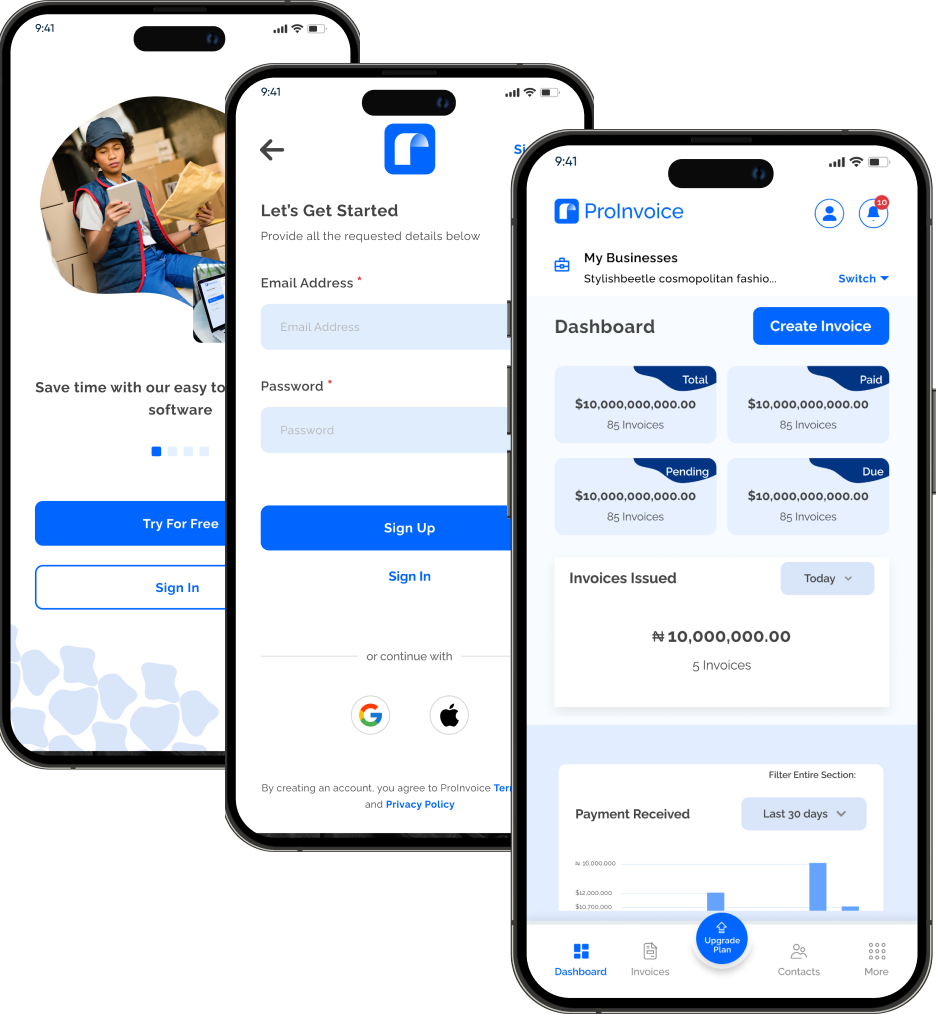1. Introduction
Economic downturns and recessions pose serious challenges for businesses. Whether it’s a global financial crisis, inflation spikes, or regional currency devaluation, the impact is often the same—tight cash flow, reduced consumer spending, shrinking profit margins, and uncertain forecasting. However, with the right strategies, you can safeguard your business and emerge stronger.
In this article, we’ll break down effective tips to manage your business finances during a recession, stabilize cash flow, and position your business for long-term sustainability. We’ll also show how using a tool like ProInvoice can streamline invoicing, improve cash collections, and give you more control during unpredictable times.
2. Understanding How Recessions Affect Business Finance
2.1 Decline in Sales and Revenue
Consumers cut spending, demand slows down, and orders reduce across sectors—especially non-essential goods and services. Businesses experience reduced cash inflow.
2.2 Delayed Customer Payments
During economic downturns, clients may stretch payment timelines. This causes increased accounts receivable balances and further strains working capital.
2.3 Rising Operational Costs
Inflation often accompanies recessions. Costs of logistics, raw materials, and even staff benefits may rise, while your ability to increase prices is limited.
2.4 Difficulty Accessing Credit
Banks and lenders tend to tighten credit terms and raise interest rates, making it harder or more expensive for small businesses to borrow.
2.5 Workforce Instability
Laying off staff becomes a difficult necessity for many businesses trying to reduce operating expenses. But poor planning here can hurt long-term recovery.
3. Top 10 Financial Tips for Managing Your Business During a Downturn
3.1 Review and Reforecast Your Budget
Take a deep dive into your existing budget. Adjust your revenue expectations and prepare multiple forecast scenarios (best, realistic, worst-case).
• Prioritize high-ROI activities.
• Cut low-impact spending.
• Track actuals vs. forecasts more frequently (weekly/monthly).
3.2 Strengthen Cash Flow Management
Cash is king—especially in a recession. Build cash reserves and plan cash flow up to 3–6 months in advance.
• Accelerate receivables.
• Negotiate extended payables where possible.
• Limit unnecessary outflows.
• Using tools like ProInvoice can help automate collections and track receivables in real time, making this step easier to implement.
3.3 Reevaluate Operating Expenses
Perform a zero-based budgeting review: Assume no cost is essential until proven otherwise.
• Renegotiate subscriptions, leases, and vendor contracts.
• Move non-core functions to freelance/contract roles.
• Consider outsourcing services like IT support or HR.
3.4 Improve Your Invoicing and Payment Collection Process
Late payments become more common during a downturn—don’t let it kill your cash flow.
• Send invoices promptly and clearly.
• Offer digital payment options.
• Use automated reminders and follow-up sequences.
ProInvoice offers these capabilities, allowing you to reduce admin time and get paid faster.
3.5 Diversify Revenue Streams
If your current revenue model is suffering, consider creating new value through:
• Complementary services
• Low-cost digital products (eBooks, templates)
• Subscriptions or recurring income offers
• Entry-level product tiers for cost-sensitive clients.
• Diversification reduces dependency on one income source.
3.6 Cut Inventory and Free Up Working Capital
Excess stock ties up capital. Adopt a lean inventory approach to minimize waste and maintain agility.
• Monitor demand closely.
• Consider “just-in-time” procurement.
• Bundle or discount stagnant stock to improve cash conversion.
3.7 Strengthen Client Relationships
This is not the time to go quiet. Stay close to your customers.
• Offer flexible payment plans or early payment discounts.
• Communicate openly about delivery timelines.
• Deliver exceptional customer service.
Loyal customers are more likely to continue buying and pay faster even during a recession.
3.8 Delay Major Capital Expenditure
Postpone high-cost upgrades or expansion unless they offer immediate ROI or strategic advantage.
• Consider renting instead of buying.
• Reuse or refurbish equipment where possible.
3.9 Monitor Key Financial Metrics
Keep a close eye on:
• Cash flow – your real-time liquidity
• Accounts receivable aging – overdue clients.
• Burn rate – monthly spend vs. income
• Profit margins – after each cost-cutting measure
Use digital dashboards (like what ProInvoice offers) to visualize these metrics and stay agile.
3.10 Leverage Technology to Reduce Manual Work
Technology can reduce overhead and give you better oversight.
• Automate invoicing and client reminders.
• Digitize financial reporting.
• Use accounting integrations to reduce bookkeeping hours.
ProInvoice allows you to create, track, and manage all invoices, reminders, and client transactions in one place.
4. How to Build a Recession-Proof Business Strategy
4.1 Build a Business Continuity Plan
Don’t wait for things to go south before you plan:
• Identify financial triggers for emergency decisions.
• Document contingency roles and responsibilities.
• Set tiered response plans based on revenue decline or cash position.
4.2 Maintain an Emergency Fund
Even in business, emergency reserves are critical. Aim for 3–6 months of core operating expenses.
• Start small—commit a fixed percentage of income monthly.
4.3 Invest in Staff Training, Not Just Cuts
While it’s tempting to downsize, consider upskilling your existing staff to take on broader roles. This keeps morale up and improves long-term productivity.
4.4 Be Transparent with Your Team
Don’t let your team operate in fear or confusion. Keep them updated with the truth and how the business is responding.
• Schedule monthly finance updates.
• Encourage innovation from all departments to cut costs or create value.
5. Common Mistakes Businesses Make During Recessions
5.1 Overcutting Expenses
Excessive cuts to marketing, customer support, or product development may reduce your competitiveness.
5.2 Ignoring Technology
Manual finance management slows you down and hides financial red flags. Automate now, not later.
5.3 Delaying Payments to Staff or Vendors
This creates internal and external distrust. Instead, renegotiate terms transparently.
5.4 Taking On High-Interest Debt Prematurely
Unless absolutely necessary, avoid emergency loans with unclear repayment conditions.
6. Why ProInvoice is the Smart Choice During a Recession
6.1 Faster Invoicing, Faster Payments
Get paid faster with clear, automated invoicing and built-in payment links for clients. Eliminate delays caused by human error or forgetfulness.
6.2 Track All Outstanding Payments in Real-Time
No more guessing who owes what. ProInvoice lets you view all pending, overdue, and completed payments in a single dashboard.
6.3 Customizable Templates & Payment Terms
Create professional, branded invoices in seconds with clear due dates, tax breakdowns, and flexible payment policies.
6.4 Automated Reminders and Late Fee Configuration
Reduce awkward calls and emails—ProInvoice sends automatic, polite follow-ups and can even apply late fees if needed.
6.5 Works Across Devices
Whether you’re working from your office, on the road, or remotely—ProInvoice keeps your business running smoothly and professionally.
7. Conclusion
Running a business during a recession is tough, but it’s also an opportunity to sharpen your operations, trim inefficiencies, and refocus on financial health. With the right tools, financial discipline, and client relationships, you can weather the storm and come out stronger.
ProInvoice is your smart partner during tough times. With automation, real-time visibility, and payment tracking, it removes guesswork and empowers your business to thrive—even in a downturn.
📌 Take action today. Visit https://proinvoice.co/ and give your business the invoicing advantage it needs to stay stable, smart, and scalable.













